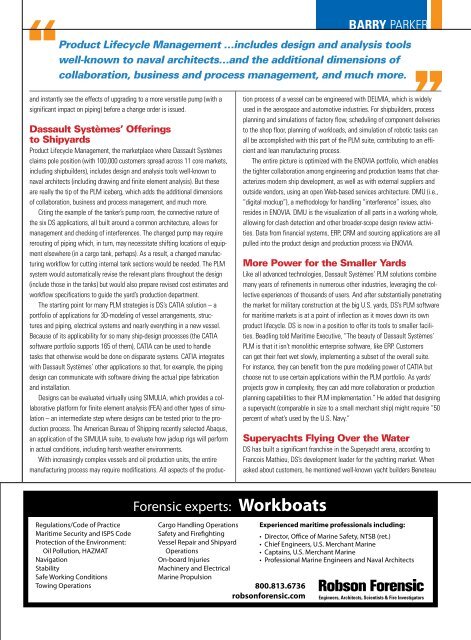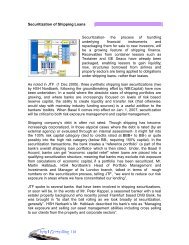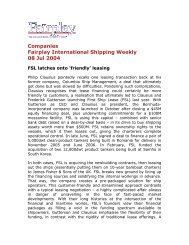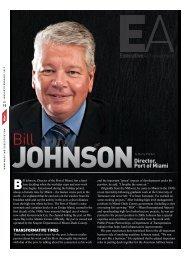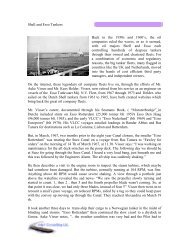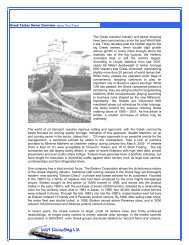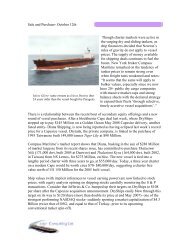Joseph S. Compofelice
Joseph S. Compofelice
Joseph S. Compofelice
You also want an ePaper? Increase the reach of your titles
YUMPU automatically turns print PDFs into web optimized ePapers that Google loves.
arry parker<br />
Product Lifecycle Management …includes design and analysis tools<br />
well-known to naval architects…and the additional dimensions of<br />
collaboration, business and process management, and much more.<br />
and instantly see the effects of upgrading to a more versatile pump (with a<br />
significant impact on piping) before a change order is issued.<br />
Dassault Systèmes’ Offerings<br />
to Shipyards<br />
Product Lifecycle Management, the marketplace where Dassault Systèmes<br />
claims pole position (with 100,000 customers spread across 11 core markets,<br />
including shipbuilders), includes design and analysis tools well-known to<br />
naval architects (including drawing and finite element analysis). But these<br />
are really the tip of the PLM iceberg, which adds the additional dimensions<br />
of collaboration, business and process management, and much more.<br />
Citing the example of the tanker’s pump room, the connective nature of<br />
the six DS applications, all built around a common architecture, allows for<br />
management and checking of interferences. The changed pump may require<br />
rerouting of piping which, in turn, may necessitate shifting locations of equipment<br />
elsewhere (in a cargo tank, perhaps). As a result, a changed manufacturing<br />
workflow for cutting internal tank sections would be needed. The PLM<br />
system would automatically revise the relevant plans throughout the design<br />
(include those in the tanks) but would also prepare revised cost estimates and<br />
workflow specifications to guide the yard’s production department.<br />
The starting point for many PLM strategies is DS’s CATIA solution – a<br />
portfolio of applications for 3D-modeling of vessel arrangements, structures<br />
and piping, electrical systems and nearly everything in a new vessel.<br />
Because of its applicability for so many ship-design processes (the CATIA<br />
software portfolio supports 165 of them), CATIA can be used to handle<br />
tasks that otherwise would be done on disparate systems. CATIA integrates<br />
with Dassault Systèmes’ other applications so that, for example, the piping<br />
design can communicate with software driving the actual pipe fabrication<br />
and installation.<br />
Designs can be evaluated virtually using SIMULIA, which provides a collaborative<br />
platform for finite element analysis (FEA) and other types of simulation<br />
– an intermediate step where designs can be tested prior to the production<br />
process. The American Bureau of Shipping recently selected Abaqus,<br />
an application of the SIMULIA suite, to evaluate how jackup rigs will perform<br />
in actual conditions, including harsh weather environments.<br />
With increasingly complex vessels and oil production units, the entire<br />
manufacturing process may require modifications. All aspects of the production<br />
process of a vessel can be engineered with DELMIA, which is widely<br />
used in the aerospace and automotive industries. For shipbuilders, process<br />
planning and simulations of factory flow, scheduling of component deliveries<br />
to the shop floor, planning of workloads, and simulation of robotic tasks can<br />
all be accomplished with this part of the PLM suite, contributing to an efficient<br />
and lean manufacturing process.<br />
The entire picture is optimized with the ENOVIA portfolio, which enables<br />
the tighter collaboration among engineering and production teams that characterizes<br />
modern ship development, as well as with external suppliers and<br />
outside vendors, using an open Web-based services architecture. DMU (i.e.,<br />
“digital mockup”), a methodology for handling “interference” issues, also<br />
resides in ENOVIA. DMU is the visualization of all parts in a working whole,<br />
allowing for clash detection and other broader-scope design review activities.<br />
Data from financial systems, ERP, CRM and sourcing applications are all<br />
pulled into the product design and production process via ENOVIA.<br />
More Power for the Smaller Yards<br />
Like all advanced technologies, Dassault Systèmes’ PLM solutions combine<br />
many years of refinements in numerous other industries, leveraging the collective<br />
experiences of thousands of users. And after substantially penetrating<br />
the market for military construction at the big U.S. yards, DS’s PLM software<br />
for maritime markets is at a point of inflection as it moves down its own<br />
product lifecycle. DS is now in a position to offer its tools to smaller facilities.<br />
Beadling told Maritime Executive, “The beauty of Dassault Systèmes’<br />
PLM is that it isn’t monolithic enterprise software, like ERP. Customers<br />
can get their feet wet slowly, implementing a subset of the overall suite.<br />
For instance, they can benefit from the pure modeling power of CATIA but<br />
choose not to use certain applications within the PLM portfolio. As yards’<br />
projects grow in complexity, they can add more collaboration or production<br />
planning capabilities to their PLM implementation.” He added that designing<br />
a superyacht (comparable in size to a small merchant ship) might require “50<br />
percent of what’s used by the U.S. Navy.”<br />
Superyachts Flying Over the Water<br />
DS has built a significant franchise in the Superyacht arena, according to<br />
Francois Mathieu, DS’s development leader for the yachting market. When<br />
asked about customers, he mentioned well-known yacht builders Beneteau<br />
Forensic experts: Workboats<br />
Regulations/Code of Practice<br />
Maritime Security and ISPS Code<br />
Protection of the Environment:<br />
Oil Pollution, HAZMAT<br />
Navigation<br />
Stability<br />
Safe Working Conditions<br />
Towing Operations<br />
Cargo Handling Operations<br />
Safety and Firefighting<br />
Vessel Repair and Shipyard<br />
Operations<br />
On-board Injuries<br />
Machinery and Electrical<br />
Marine Propulsion<br />
Experienced maritime professionals including:<br />
• Director, Office of Marine Safety, NTSB (ret.)<br />
• Chief Engineers, U.S. Merchant Marine<br />
• Captains, U.S. Merchant Marine<br />
• Professional Marine Engineers and Naval Architects<br />
800.813.6736<br />
robsonforensic.com<br />
Engineers, Architects, Scientists & Fire Investigators<br />
NOVEMBER/DECEMBER 2008 | 61


